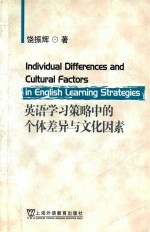

英语学习策略中的个体差异与文化因素PDF格式文档图书下载
- 购买点数:12 点
- 作 者:饶振辉著
- 出 版 社:上海:上海外语教育出版社
- 出版年份:2007
- ISBN:7544604802
- 标注页数:336 页
- PDF页数:354 页
CHAPTER 1 Introduction 1
1.0 Introduction 1
1.1 Current Trends in Research on Individual Differences in L2 Acquisition 2
1.2 Hypotheses and Significance of This Study 6
1.3 An Outline of the Book 7
CHAPTER 2 Review of Research on Language Learning Strategies 9
2.0 Introduction 9
2.1 Defining and Categorizing Learning Strategies 10
2.1.1 Defining Learning Strategies 10
2.1.2 Categorizing Learning Strategies 16
2.2 Learning Strategies and Language Learning 23
2.2.1 The"Good Language Learner"Studies 23
2.2.2 Correlational Studies Employing Statistical Procedures 26
2.3 Strategic Performance in Different Language Skill Areas 31
2.3.1 Listening 32
2.3.2 Speaking 33
2.3.3 Reading 35
2.3.4 Writing 37
2.3.5 Vocabulary Learning 38
2.4 Factors Affecting Choice of Language Learning Strategies 39
2.4.1 Cultural Heritage 40
2.4.2 Motivation 42
2.4.3 Age and Gender 43
2.4.4 Career Orientation 45
2.4.5 Educational Setting 46
2.5 Conclusion 48
CHAPTER 3 Theoretical Foundation for the Study of Language Learning Strategies in L2 Acquisition 50
3.0 Introduction 50
3.1 Theoretical Development in the Study of LLS in L2 Acquisition 51
3.2 Anderson's Adaptive Control of Thought(ACT)Model 53
3.2.1 Language Learning as Cognitive Learning 54
3.2.2 LLS as Cognitive Skills 57
3.3 Biggs's Student Approaches to Learning(SAL)Framework 64
3.3.1 Surface,Deep and Achieving Approaches to Learning 64
3.3.2 Learning Strategies in the SAL Framework 69
3.4 Gardner's Social-educational Model 73
3.4.1 The Interplay of Social-psychological Variables in the Social-educational Model 74
3.4.2 The Influence of Social-psychological Variables on Students'Choice of LLS 78
3.5 Conclusion 81
CHAPTER 4 Research Methodology 84
4.0 Introduction 84
4.1 The Goals of This Study 84
4.2 Methodological Approach 86
4.3 Adoption and Adaptation of the SILL 91
4.3.1 Procedures 93
4.3.2 Adaptation of the SILL 93
4.3.3 Limitations of the Adapted SILL 99
4.4 Data Collection and Analysis 100
4.4.1 Quantitative Study 100
4.4.2 Qualitative Study 106
4.5 Ethical Considerations 111
4.6 Conclusion 112
CHAPTER 5 The Cultural and Edueational Context of the Present Study 114
5.0 Introduction 114
5.1 The Influence of Chinese Culture on Students'Ways of Learning 115
5.1.1 Collectivism and Interdependent Self in the Chinese Culture 116
5.1.2 Socialization for Achievement 118
5.1.3 Attitudes to Power and Authority 120
5.2 Chinese Traditional Education 122
5.2.1 Overview of Chinese Traditional Education 123
5.2.2 Maxims Concerning Teaching and Learning 124
5.3 EFL Teaching in China 127
5.3.1 Development of EFL Teaching in China 127
5.3.2 Difficulties and Challenges for EFL Teaching in China Today 131
5.3.3 Common Features of Teaching and Learning English in the Chinese Context 133
5.3.4 Some Current Social-economic Influences on Chinese Learners of English 135
5.4 EFL Teaching and Learning in Chinese Universities 137
5.4.1 Teachers 137
5.4.2 Students 139
5.4.3 The English Intensive Reading Course in China 141
5.5 Conclusion 143
CHAPTER 6 Results 145
6.0 Introduction 145
6.1 Differences in Overall Strategy Use 145
6.1.1 The Quantitative Data 146
6.1.2 The Qualitative Data 148
6.2 Differences in Strategy Use in the Six SILL Categories 156
6.2.1 The Quantitative Data 157
6.2.2 The Qualitative Data 162
6.3 Differences in Use of Each Strategy by English Proficiency 179
6.3.1 The Quantitative Data 179
6.3.2 The Qualitative Data 189
6.4 Differences in Use of Each Strategy by Gender 216
6.5 Conclusion 221
CHAPTER 7 Discussion of Results:Factors Affecting Students'Use of Learning Strategies 222
7.0 Introduction 222
7.1 Cultural Factors 223
7.1.1 Collectivist Value 224
7.1.2 Self-determination 225
7.1.3 Perseverance 225
7.1.4 Teacher's Authority 226
7.2 Student Factors 227
7.2.1 English Proficiency 227
7.2.2 Motivation 244
7.2.3 Students'Approaches to Learning 246
7.2.4 Major Field of Study 256
7.2.5 Gender 258
7.3 Teaching Context Factors 263
7.3.1 Educational Pattern 263
7.3.2 L2 Acquisition Context 269
7.4 Conclusion 273
CHAPTER 8 Conclusions and Implications 276
8.0 Introduction 276
8.1 Summary of Major Findings in This Study 277
8.1.1 Findings Regarding Strategic Differences Between Individual Students 277
8.1.2 Findings Regarding the Influence of Chinese Culture and Education on Students'Strategy Use 280
8.2 Theoretical Implications 281
8.3 Pedagogical Implications 283
8.3.1 Promoting Strategy Use by Strategy Training 283
8.3.2 Promoting Strategy Use by Diversifying EFL Teaching Methods 286
8.4 Suggestions for Future Research 288
8.5 Conclusion 290
BIBLIOGRAPHY 292
APPENDICES 309
1.Classification of Learning Strategies in L2 Acquisition by Wong-Fillmore(1976) 309
2.Classification of Learning Strategies in L2 Acquisition by Naiman et al.(1978) 310
3.Classification of Learning Strategies in L2 Acquisition by Rubin(1981) 311
4.Classification of Learning Strategies in L2 Acquisition by Chamot and O'Malley(1994) 312
5.Classification of Learning Strategies in L2 Acquisition by Oxford(1990) 314
6.Semi-structured Interview 316
7.Changed Items in the Adapted SILL 317
8.A Letter of Invitation 319
9.Information Sheet(A) 320
10.Consent Form(A) 322
11.Strategy Inventory for Language Learning 323
12.Information Sheet(B) 330
13.Consent Form(B) 332
14.Structured Interview Guide 333
15.Semi-structured Interview Guide 334
16.A Sample of Reading Lesson Plan 335
- 《英语学习策略中的个体差异与文化因素》饶振辉著 2007
- 《动态系统理论视角下的英语学习者个体差异研究》崔刚,柳鑫淼,杨莉著 2016
- 《英语学习者个体差异动态系统研究》柳鑫淼著 2014
- 《外语学习者个体差异与学习自主性》郝玫编著 2012
- 《英语教学中差异性教学策略研究》马爱军编著 2018
- 《学习者个体差异与外语教学》卢敏著 2015
- 《思维风格与听力学习策略》王沁著 2011
- 《世俗理性主义:消费者决策的个体差异》王晗蔚著 2018
- 《中国文化背景与英语阅读》彭思祥著 2014
- 《英语教学论》欧阳俊林主编 2007
- 《上海方言词汇集》(英)艾约瑟(J.Edkins)编著 2016
- 《WEB+DB PRESS中文版 2》日本技术评论社编 2015
- 《THE GOVERNMENT/PRESS CONNECTION PRESS OFFICERS AND THEIR OFFICES》STEPHEN HESS 1984
- 《PRESS》POLITICS & PUBLIC OPINION IN BIHAR 1912-1947 2010
- 《Press law》Robin Callender Smith. 1978
- 《SUING THE PRESS》RODNEY A.SMOLLA 1986
- 《THE PRESS AND AMERICA》 2222
- 《FREEDOM OF THE PRESS》ERIC BARENDT 2009
- 《FREEDOM OF THE PRESS》ROB EDELMAN 2006
- 《FREEDOM OF THE PRESS》DAVID L.GEBERT 2005
